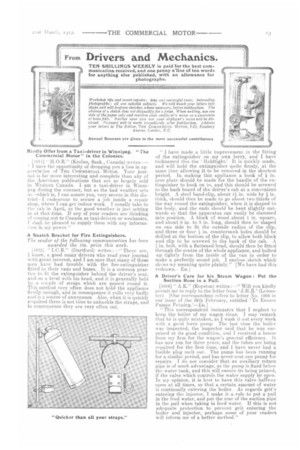From Drivers and Mechanics.
Page 19

If you've noticed an error in this article please click here to report it so we can fix it.
TEN SHILLINGS WEEKLY is paid for the best communication received, and one penny aline of ten words for anything else published, with an allowance for photographs.
Workshop tips and smart repairs: long and successful runs: interesting Photographs ; all are suitable subjects. We will knock your letters into shape and will prepare sketches, where necessary, before bublication. The absence of a sketch does not disqualify for a prise. When writing, use one side of the paper only and mention your employer's name as a guarantee of bona fides. Neither your own nor your emPloyer's name will be disclosed. Payment will be made imnedialely after publication. Address your letters to The Editor, THE COMMERCIAL MOTOR, 7-15, Rcsebery
Avenue. London, P.C.
Annual Bonuses are given to the most successful contributors
Madly Offer from a Taxi-driver in Winnipeg. "The Commercial Motor" in the Colonies.
[1011] '' 11.0.R." (Krolan, Sask., Canada) writes :—
have the opportunity of dropping you a line in appreciation of THE COMMERCiAE Mown, Your journal is far more interesting and complete than any of the American publications that are so largely sold in Western Canada. I am a taxi-driver in Winnipeg during the summer, but as the bad weather sets in—which is, I can assure you, very severe in this district—I endeavour to secure a job inside a repair shop, where I can get indoor work. I usually take to the cab in April, as the good weather is just setting in at that time. If any of your readers arc thinking of corning out to Canada. as taxi-drivers or mechanics, I shall he pleased to supply them with any information in my power."
A Snatch Bracket for Fire Extinguishers.
The sender of the following communication has been awarded the I0s. prize this week.
[1015] " I.C.B." (Dartford) writes :—" There are, I know, a good many drivers who read your journal with great interest, and I am sure that many of these men have had trouble with the fire-extinguisher fitted to their vans and buses. It is a common practice to fit the extinguisher behind the driver's seat, and on a level with his head, and it is generally held. by a couple of straps which are passed round it. This method very often does not hold the appliance fi roily enough, and in consequence it rolls very badly and is a source of annoyance. Also, when it is quickly required there is not time to unbuckle the straps, and in consequence they are very often cut. " I have made a little improvement in the fitting of the extinguisher on my own lorry, and I have nicknamed this the Holdtight.' It is quickly made, and will hold the extinguisher quite firmly, at the same time allowing it to be removed in the shortest period. In making this appliance a hook of * iron plate should be made for the handle of the extinguisher to hook on to, and this should be screwed to the back board of the driver's cab at a convenient height. A steel band-clip, about Ei in. wide by in. thick, should then be made to go about two-thirds of Lime way round the extinguisher, when it is shaped to the body, and the ends should be bent. slightly outwards so that the apparatus can easily be slammed into position. A block of wood about 1 in. square, and about 6 in. to 8 in. long, should then be shaped on one side to fit the outside radius of the clip, and three or four in. countersunk holes should be drilled at the bottom of the clip, to allow both block and clip to be screwed to the back of the cab. A 1.4 in. bolt, with a flattened head, should then be fitted through the centre of the whole appliance, and bolted up tightly from the inside of the van in order to make a perfectly sound job. I enclose sketch which shows rny meaning quite plainly." [We have had this redrawn.—End
A Driver's Care for his Steam Wagon Put the Suction Rose in a Pail.
[101.0] " A.K." (Royston) writes :----" Will you kindly permit me to reply to the letter from J.H.R.' (Leicester). [Our correspondent refers to letter No. 1005 in our issue of the 29th February, entitled To Ensure pumps Priming, '—En.j SrThis correspondent insinuates that I neglect to keep the boiler of my wagon clean. I may remark that he is quite mistaken, as I wash it out every week with a good force pump The Mat time the boiler was inspected, the inspector said that he was surprised at its good condition, and I received a bonus from my firm for the wagon's general efficiency. It has now run for three years, and the tubes are being repaired for the first time, and I have never had a fusible plug melt out. The pump has been running for a similar period, mid has never cost one penny for repairs. I do not consider that an auxiliary return pipe is of much advantage, as the pump is fixed below the water tank, and this will ensure its being primed, if the valve which controls the water supply be open. In my opinion, it is best to have this valve halfway open at all times, so that a certain amount of water is continually entering the boiler. As regards grit's entering the injector, I make it a rule to put a pail in the feed water, and put the rose of the suction pipe in the pail when taking in feed water. If this is not adequate protection to prevent grit entering the boiler and injector, perhaps some of your readers will inform me of a better method."




















